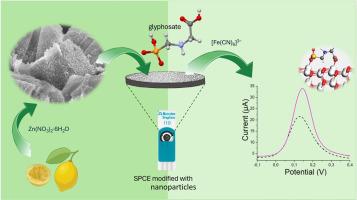ZnO-nanostructured electrochemical sensor for efficient detection of glyphosate in water
IF 3.7
Q1 CHEMISTRY, ANALYTICAL
引用次数: 0
Abstract
Glyphosate is a widely used broad-spectrum herbicide for controlling grassy weeds, despite having potential health hazards. Herein, we report on a solid-state electrochemical sensor based on ZnO nanoparticles (ZnO NPs) for on-site detection of glyphosate. Accordingly, ZnO NPs was drop-cast on the surface of a disposable screen-printed carbon electrode. Eco-friendly ZnO NPs of only 7 nm crystallite sizes were obtained by green sol-gel synthesis using lemon (Citrus limon) waste aqueous extract as the green reducing and capping/stabilizing agent and Zn nitrate precursor as evidenced by scanning electron microscopy (SEM), transmission electron microscopy (TEM), X-ray diffraction and diffuse reflectance. SEM confirmed successful electrode functionalization with the synthesized nanoparticles. Under laboratory conditions in acetate buffer (pH 5), the sensor demonstrated excellent selectivity and sensitivity, with a detection limit of 0.648 µM, a wide linear detection range (0.5 µM to 7.5 mM), and a rapid detection time of 30 min. When tested in river water, the sensor achieved a detection limit of 0.96 µM using differential pulse voltammetry. It also exceptionally tolerated interference from similar organophosphorus compounds and ions commonly found in river water. The excellent detection performance of the sensor was attributed to the strong coordination interactions between Zn atoms and phosphonate/carboxylate groups that are enhanced by a hydrogen bond at acidic pH, as determined by chemical calculations. This disposable sensor offers a cost-effective, efficient, and environmentally friendly solution for monitoring glyphosate in water systems.

高效检测水中草甘膦的zno纳米结构电化学传感器
草甘膦是一种广泛使用的用于控制杂草的广谱除草剂,尽管它有潜在的健康危害。在此,我们报道了一种基于ZnO纳米粒子(ZnO NPs)的固态电化学传感器,用于草甘膦的现场检测。因此,ZnO NPs被滴铸在一次性丝网印刷碳电极表面。通过扫描电镜(SEM)、透射电镜(TEM)、x射线衍射和漫反射分析,以柠檬(Citrus limon)废水提物为绿色还原剂和封盖/稳定剂,以硝酸锌为前驱体,采用绿色溶胶-凝胶法合成了粒径仅为7 nm的环保型ZnO纳米粒子。SEM证实了合成的纳米颗粒成功实现了电极功能化。在实验室条件下,在醋酸缓冲液(pH 5)中,该传感器表现出优异的选择性和灵敏度,检测限为0.648µM,线性检测范围宽(0.5µM至7.5 mM),检测时间快速为30 min。在河水中测试时,采用差分脉冲伏安法,该传感器的检测限为0.96µM。它还特别耐受河水中常见的类似有机磷化合物和离子的干扰。根据化学计算,该传感器的优异检测性能归因于锌原子与膦酸盐/羧酸盐基团之间的强配位相互作用,在酸性pH下,氢键增强了这种配位相互作用。这种一次性传感器为监测水系统中的草甘膦提供了一种经济、高效和环保的解决方案。
本文章由计算机程序翻译,如有差异,请以英文原文为准。
求助全文
约1分钟内获得全文
求助全文

 求助内容:
求助内容: 应助结果提醒方式:
应助结果提醒方式:


